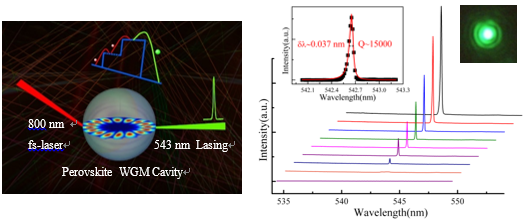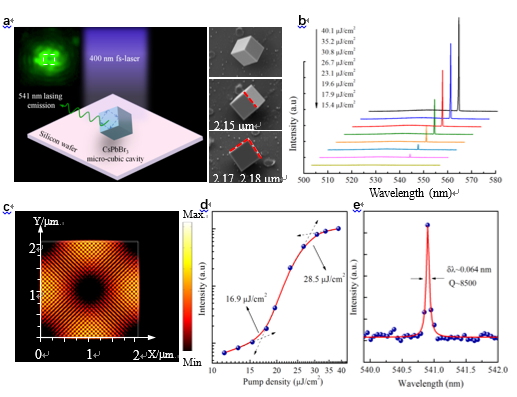Miniaturized ultrahigh Q (quality factor) semiconductor nanolasers with single mode lasing output and narrow linewidth are in big demand in physics and engineering applications, such as on-chip photonics integration, coherent sensing, and quantum information processing.
However, constrained by microcavity structure and limited optical gain, the realization of ultrahigh Q single-mode lasing in self-constructed microcavity is still a great challenge. By Vernier effect or reducing the cavity size, single-mode lasing can be observed in few cavity structures. However, most nanolasers show relatively low Q factor (500-3000), limited by cavity shape and material.
Recently, lead halide perovskites, star semiconductor materials in photovoltaic field, have been demonstrated as new laser gain material. Perovskite nanolasers with high Q (1000-3600) have been observed in several common microstructures, such as nanowire, nanorod and naodisk.
Therefore, to achieve ultrahigh Q single-mode lasing in naturally formed microcavity, new material with high optical gain, novel cavity structure should be further explored.
The research team led by Professor ZHANG Long from Key Laboratory of Materials for High Power Lasers, Shanghai Institute of Optics and Fine Mechanics, together with National Lab for Infrared Physics, Shanghai Institute of Technical Physics of the Chinese Academy of Sciences (CAS) and Hunan University, has demonstrated ultrahigh Q single-mode laser with much narrow linewidth and low threshold in CsPbBr3 perovskites with novel spherical and cubic structure.
In CsPbBr3 microsphere (D~780 nm), Ultrahigh Q~1.5×104 upconverted single mode lasing at room temperature has been realized in an individual sphere, with much narrow linewidth (δλ~0.037 nm), low threshold (PTh~203.7 μJ/cm2) under two-photon excitation. The 800 nm femtosecond laser (~40 fs, 10 kHz) was used as excitation source to uncover the single-mode lasing properties of CsPbBr3 microspheres under ambient environment.
Moreover, single-mode lasing at any angle between -30o and 30o can be detected during the angle-resolved measurements, confirming the nearly uniform emission properties of spherical microcavity. Modulating the cavity size, ultrahigh Q~1.0×104 single mode lasing wavelength can be tuned. Notably, the Q factor of single-mode lasing can be further improved to ~3.0×104 at 80 K, which is the highest value reported in naturally formed microresonators.
In CsPbBr3 microcube (~2 mm), high quality and stable single-mode lasing was obtained at room temperature through reducing the size of micro-cubic cavity. The lasing mode linewidth is 0.064 nm (Q~8500). The 400 nm femtosecond laser (~40 fs, 10 kHz) was used as excitation source. Different growth stages of cavities were found and related growth mechanism was analysed, indicating that micro-cubic cavities were evolved from nanospheres.
Besides, researchers also noticed several interesting multi-mode lasing spectra with sub-modes in lager microcubes, which confirm the existence of higher order transverse modes in 3D CsPbBr3 microcubes for the first time.
These works pose a simple and straight way to achieve ultrahigh Q single-mode lasing, and hold great promise for micro/nanolasers, chip-level integration and photonic devices at nanoscle.
The results, entitled “Ultrahigh Quality Upconverted Single-Mode Lasing in Cesium Lead Halide Bromide Spherical Microcavity” and “Single-mode lasing and 3D confinement from perovskite micro-cubic cavity” were published in Advanced Optical Materials and Journal of Materials Chemistry C, respectively.

Characterizations of perovskite CsPbBr3 microspheres (Image by SIOM)

Characterizations of perovskite CsPbBr3 microcubes (Image by SIOM)
Contact:
Mr. Cao Yong
General Administrative Office
Shanghai Institute of Optics and Fine Mechanics, CAS
Email: caoyong@siom.ac.cn